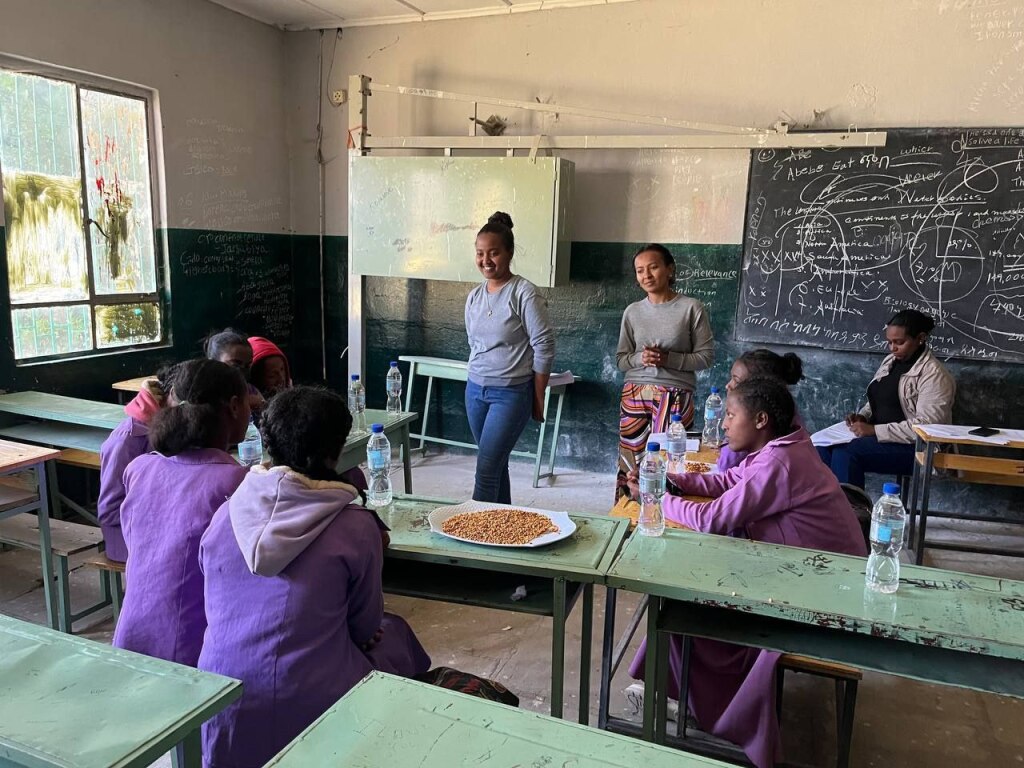
Power To Youth (Ethiopia Innovation Challenge)
Situation
Different forms of Gender Based Violence (GBV) prevail in the Ethiopian context where up to 71% of women and girls in the country have reported experiencing some form of gender-based violence in their lifetime. Within this, a systematic study conducted among young female students by Alemu et al. in 2022 shows that the overall pooled prevalence of lifetime gender-based violence among Ethiopian high school students of 50%. Gender-based violence in school settings remains largely unaddressed and continues to create a significant threat to the well-being and academic success of young adolescent girls. School girls’ vulnerability to GBV is exacerbated by a combination of contextual challenges including:
1. A lack of attention by school institutions who are either unaware of the extent of GBV in their schools or are unwilling to confront it due to social, cultural and systemic barriers.
2. A lack of resources and infrastructure to provide comprehensive GBV education to all students.
3. A lack of tools and skills among students that can help them recognize and address cases of GBV.
4. A wide range of harmful beliefs and attitudes among students that shape their understanding of GBV and their relationships with each other.
Assignment
The problem we are trying to solve is the high rate of in-school gender-based violence that negatively affects girls’ educational and overall well-being, To minimize in-school GBV the team has identified a gap in comprehensive gender-based violence education that prohibits girls and boys from effectively recognizing, reporting and addressing cases of GBV in their respective schools. Despite extracurricular interventions in schools such as gender clubs, our research shows that schools struggle to craft and deliver contextually relevant, engaging and informative GBV education through these platforms. In addition, existing access to SRH education is not accessible to male students as GBV is largely considered a women’s/girls’ issue. The HMW statement framed by the team reads:
“HMW address gaps in GBV education to create a safe school environment for students?”
This framing emphasizes the need to create a safe learning environment by addressing gaps in GBV education. The team began the process with the goal of identifying the context of in-school GBV including factors that cause and influence it as well as protection and accountability mechanisms that protect girls where it occurs. Through research and testing, the team learned that the lack of GBV education is a key barrier that prevents students from recognizing and reporting GBV.
Approach
Sensitization: In this stage, the team was introduced to Human Centered Design (HCD) over a two-day sensitization workshop that provided a deep dive into the processes, mindsets and methodologies used in HCD. In the first part of the workshop, the team was sensitized to what is meant by HCD, its different stages and the tools and principles that they can leverage to create a tailored solution that are responsive to the needs, experiences, and aspirations of their selected target group. In the second part of the training, the team used their learnings from the Power to Youth mid-term evaluation to identify a design challenge, in school GBV. Additionally, the team conducted an empathy map exercise to deepen their understanding of the context, motivations, and challenges faced by adolescent girls experiencing GBV, further informing their continued understanding of their target.
Discovery Phase: During this phase, the team learned to utilize participatory HCD tools to plan and conduct design research. In preparation of the field research, the team identified three target groups, co-designed a facilitation guide to facilitate field research and recruited research participants. The team also conducted design research, using HCD activities to understand the challenges faced by students regarding GBV. The primary objectives of the research were to identify the context of (S)GBV in school environments; factors that cause and/or influence GBV in schools and existing protection and accountability mechanisms including risks, barriers and good practices.
Create phase: During this phase, the team attended a 4-day design workshop, where the team created a wide range of ideas that could remedy challenges faced by girls regarding in-school gender-based violence. Selected ideas were developed into concepts which were then built into prototypes. In this stage, the team explored methods for creating innovative solutions to address GBV in schools, emphasizing the importance of designing solutions that are feasible, desirable, and viable within the context of the target community. This phase encouraged critical thinking and strategic planning to ensure that the proposed interventions effectively addressed the root causes of in-school GBV.
Pilot Preparation: In this phase, the team shifted their focus towards refining and evaluating their prototypes based on feedback from users. Through the process, the team consolidated their prototypes into an awareness creation as they learned that the awareness gap is a primary cause of in-school GBV. Here, the team also mapped existing interventions, identified potential partners and stakeholders as well as developed a sustainability model for continued implementation in the pilot phase.
Results
As a result of the innovation challenge, the Ethiopia team crafted an interactive game that encourages school students to work together to deepen their understanding of GBV and its impact. Through engaging activities and discussions, the game aims to challenge negative attitudes and promote desired behaviours that contribute to a more respectful and inclusive learning environment. The prototype proposes to restructure preexisting gender clubs in schools to provide o customized, age appropriate and contextually relevant GBV education for male and female students. The project aims to Involve key stakeholders such as school administrators, teachers and students throughout the process, creating a sense of responsibility and increasing the likelihood of sustained support. In addition to the creation of the prototype, the innovation challenge also helped the country team to practice creative and participatory solutions which they will continue to implement in their daily activities.
This project was commissioned by Amref Health Africa, and delivered by a consultant of Proportion Global. If you’ve enjoyed reading this case and want to dive deeper, we’d love to hear from you. Contact us to discuss ideas, ask questions, or explore collaboration. Contact Us


Responses